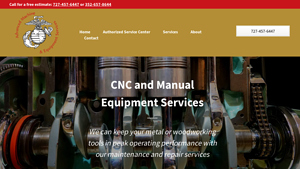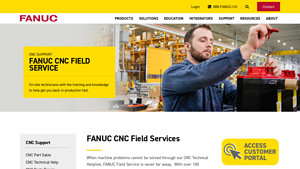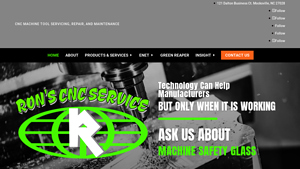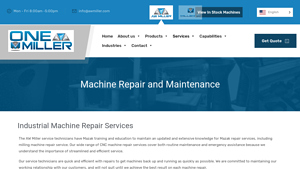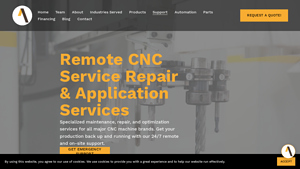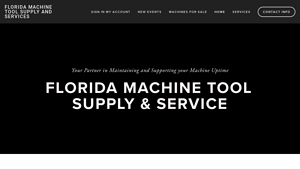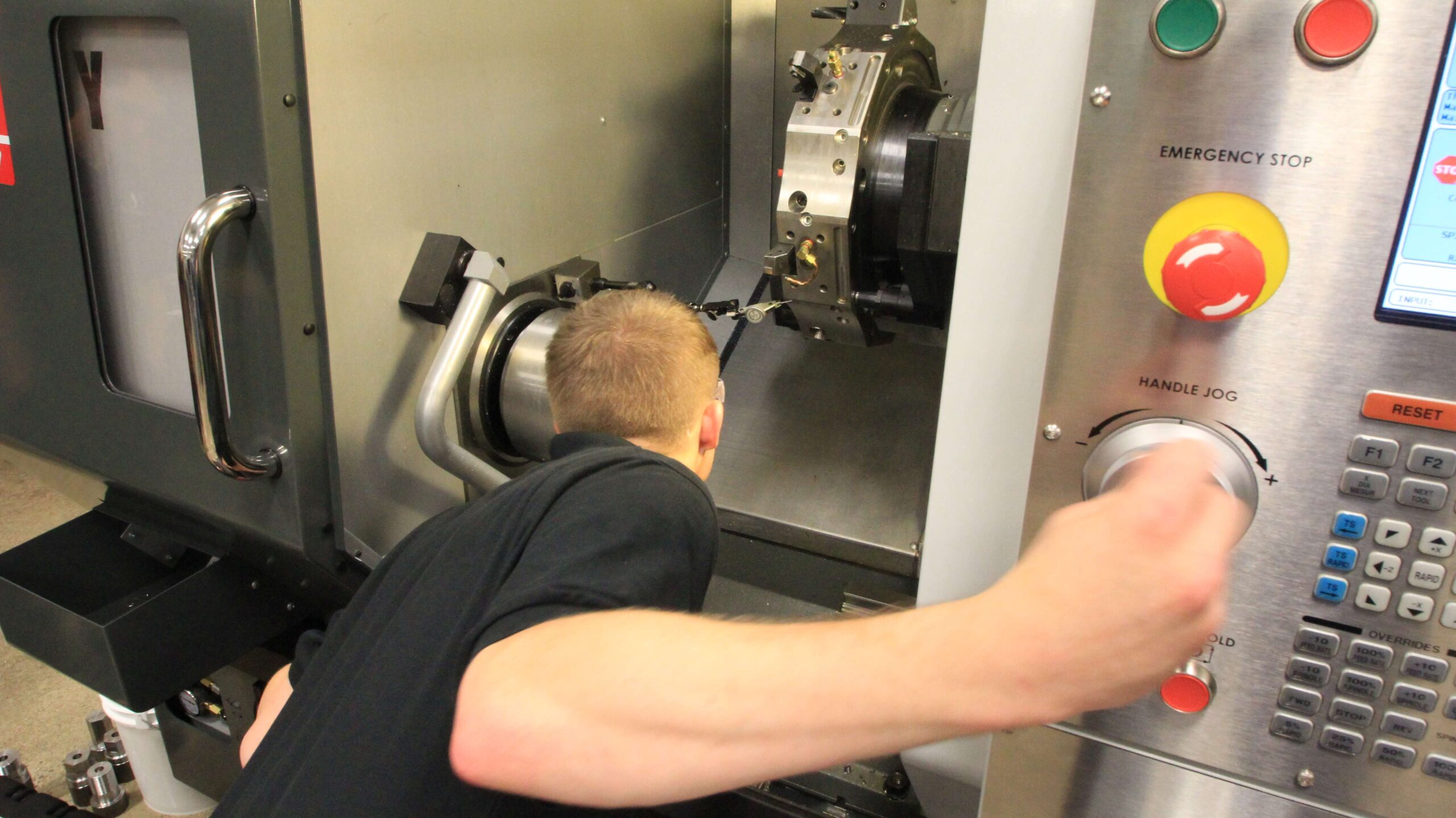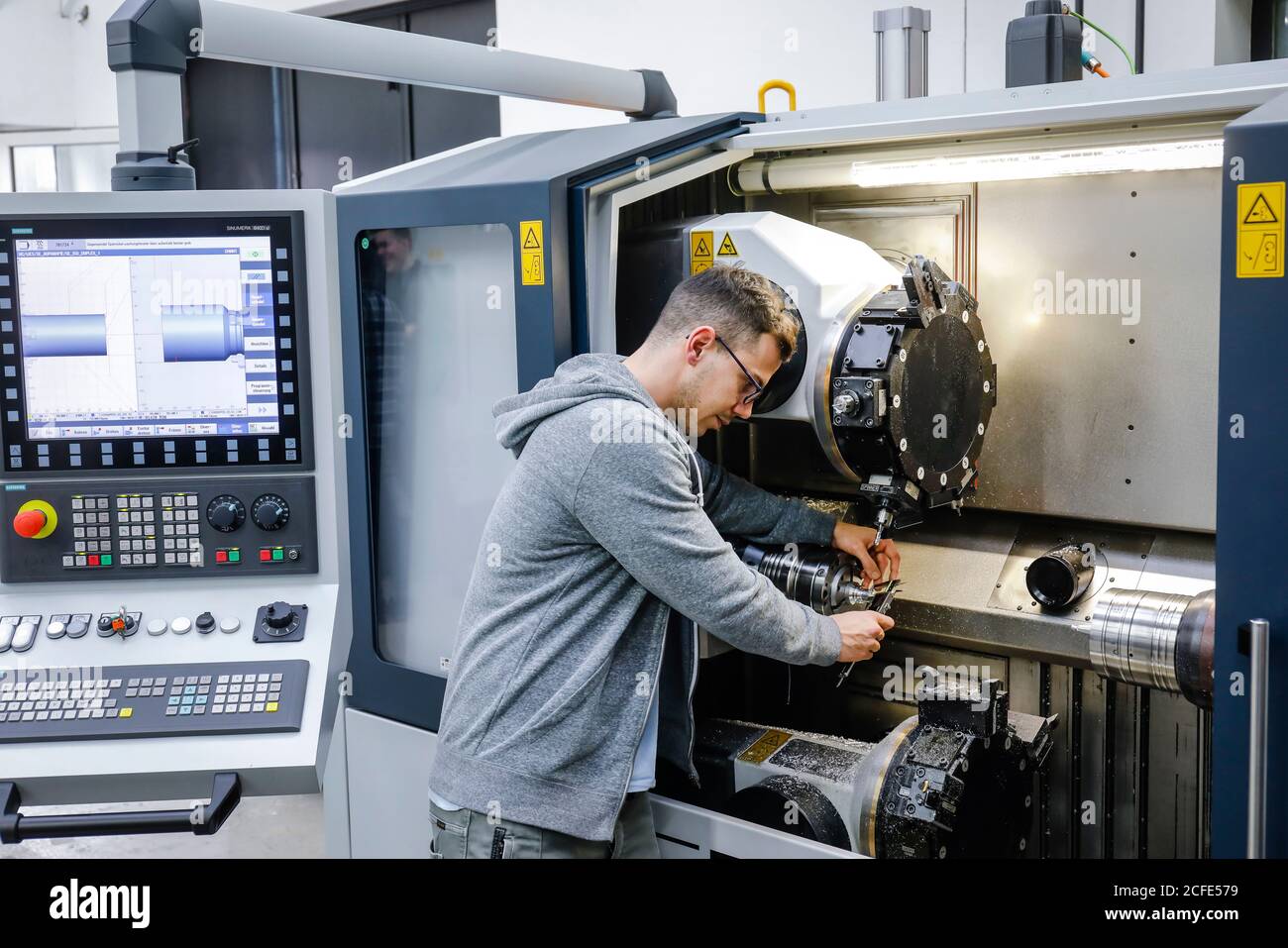Top 8 Cnc Repair Service List and Guide
Top 8 Cnc Repair Service Manufacturers & Suppliers List
1. APTM Tools – CNC Machine Services
Domain: aptmtools.com
Registered: 2011 (14 years)
Introduction: Machine Tool Parts and Repair services including CNC Machine Services in Florida. Key products include: CNC Machine Tools, Machining Centers (Vertical, Horizontal, 5-Axis), Boring Mills, Bridge Mills, Double Column Machining Centers, Turning Centers (2-Axis, Y-Axis, Multi-Turret, Multifunction Mill, Vertical, Twin Spindle, Swiss Lathes), Automation (Cobots/Robotics, Pallet Pools, Gantry Systems, B…
2. Advanced Machine – CNC & Manual Equipment Services
Domain: advancedmachinefl.com
Registered: 2022 (3 years)
Introduction: CNC and Manual Equipment Services in Hudson, FL. Services include maintenance and repair for both CNC and manual machinery. Expertise in metal working and wood working equipment. Comprehensive services include preventative maintenance, equipment diagnostics, CNC repairs, equipment alignments, and more. Specialization in repairing all makes and models of CNC equipment, including live tools, aggrega…
3. FANUC – CNC Field Service
Domain: fanucamerica.com
Registered: 1998 (27 years)
Introduction: FANUC CNC Field Service provides on-site technicians trained to resolve machine problems quickly, minimizing downtime. Key offerings include: factory-trained engineers, local support from Service Centers and Satellite locations, direct access to technical data for troubleshooting, and the ability to bring replacement parts on-site. FANUC has over 100 technicians across North America, ensuring fast…
4. Productivity Inc. – CNC Machine Tool Repair
Domain: productivity.com
Registered: 1991 (34 years)
Introduction: Productivity Inc. is a CNC machine tool repair provider offering services for manufacturing facilities and machine shops in the Upper Midwest and Rocky Mountain regions. They provide fast response times to maximize machine uptime, with services dedicated to various types of CNC machines including milling and lathe machines, machining and turning centers, fabrication equipment, micro-milling machin…
5. Ron’s CNC Service – CNC Components & Machine Repairs
Domain: ronscnc.com
Registered: 2002 (23 years)
Introduction: Products and Services offered by Ron’s CNC Service include: 1. eNET CNC and DNC components 2. Machine Safety Glass 3. Machine Tool Repairs 4. Service & Maintenance 5. Ball Screw Repair and Rebuild 6. Spindle Repair and Rebuild 7. Hydraulic/Pneumatic and Mechanical pumps, motors, valves, cylinders & power units 8. Drive and Circuit Board Cleaning 9. O.C. White Machine Lighting 10. O.C. White LED In…
6. AW Miller – CNC Machine Repair Services
Domain: awmiller.com
Registered: 1998 (27 years)
Introduction: CNC Machine Repair Services, Routine Maintenance, Emergency Assistance, Mazak Training, Mazak Replacement Parts, $90 million in parts and unit inventory, 97% same-day shipping, lifetime parts support, industrial machine maintenance benefits, certified service technicians, service areas include Buffalo, NY; Pittsburgh, PA; Montreal, QC; Harleysville, PA; industries served include Aerospace, Automot…
7. Anderson America – Remote CNC Services
Domain: andersonamerica.com
Registered: 2002 (23 years)
Introduction: Remote CNC Service Repair & Application Services, specialized maintenance, repair, and optimization services for all major CNC machine brands, 24/7 remote and on-site support, remote diagnostics, preventive maintenance, operator training, emergency repairs, software updates & integration, parts replacement, 50+ years of excellence in CNC machine service and support, expertise in Fanuc technology, …
8. Florida Machine Tool – CNC & Manual Tool Services
Domain: flmachinetool.com
Registered: 2014 (11 years)
Introduction: Florida Machine Tool Supply and Services specializes in preventive maintenance, repair, and upgrade services for CNC and manual machine tools. Key services include:
– Preventive maintenance plans tailored to specific equipment needs
– Regular inspections, cleaning, lubrication, and replacement of worn parts
– Machine installation, removal, leveling, ball bar testing, and laser alignment
– PLC and …
Introduction: Navigating the Global Market for cnc repair service
In today’s fast-paced manufacturing landscape, sourcing reliable CNC repair services can pose a significant challenge for businesses aiming to minimize downtime and optimize production efficiency. As international B2B buyers, particularly from regions like Africa, South America, the Middle East, and Europe—including key markets such as Brazil and Saudi Arabia—you face unique hurdles, including varying service standards, lead times, and logistical complexities. This comprehensive guide on CNC repair services aims to empower you with the knowledge needed to navigate this global market effectively.
Throughout this guide, we will explore various types of CNC repair services, the specific applications they cater to, and the essential criteria for vetting suppliers. You’ll gain insights into the cost structures associated with repairs versus replacements, the importance of timely service, and how to assess the capabilities of service providers. By equipping yourself with actionable information, you can make informed purchasing decisions that not only save costs but also enhance the longevity and performance of your CNC machinery.
Whether you are managing an extensive manufacturing facility or a small workshop, understanding the landscape of CNC repair services will enable you to mitigate risks, avoid unexpected downtimes, and ensure that your operations run smoothly and efficiently.
Understanding cnc repair service Types and Variations
| Type Name | Key Distinguishing Features | Primary B2B Applications | Brief Pros & Cons for Buyers |
|---|---|---|---|
| Drive Repair Services | Focus on repairing servo and vector drives; quick turnaround | CNC machining operations requiring minimal downtime | Pros: Fast service; cost-effective. Cons: May not cover all brands. |
| Emergency Repair Services | 24/7 availability; rapid response to breakdowns | Industries with high production demands | Pros: Immediate support; minimizes downtime. Cons: Higher costs for urgent services. |
| Preventative Maintenance | Regular checks and servicing to prevent breakdowns | Long-term maintenance of CNC machines | Pros: Reduces unexpected failures; increases machine lifespan. Cons: Ongoing costs may add up. |
| Component Reverse Engineering | Custom solutions for obsolete parts; tailored manufacturing | Older CNC machines needing specific replacements | Pros: Saves costs on OEM parts; tailored solutions. Cons: Longer lead times for custom parts. |
| Full Machine Rebuilds | Comprehensive restoration of CNC machines; extensive testing | Aging equipment needing significant upgrades | Pros: Extends machine life; improves performance. Cons: Higher initial investment; longer downtime. |
What are the Key Characteristics of Drive Repair Services?
Drive repair services specialize in the restoration of CNC servo and vector drives, ensuring that these critical components are functioning efficiently. Typically, these services offer quick turnaround times, often shipping repaired or replacement drives within a few days. For businesses that rely heavily on CNC machining, minimizing downtime is essential, making these services particularly valuable. When considering drive repair, B2B buyers should evaluate the service provider’s experience with specific brands and their ability to deliver on tight schedules.
How Do Emergency Repair Services Benefit Businesses?
Emergency repair services are designed for businesses that cannot afford lengthy downtimes due to equipment failure. With 24/7 availability, these services provide rapid response to urgent breakdowns, ensuring that production lines can resume as quickly as possible. While the immediate support is a significant advantage, buyers should be aware that emergency services often come with higher costs. Evaluating the service provider’s response times and past performance can help businesses make informed decisions when selecting an emergency repair partner.
Why is Preventative Maintenance Important for CNC Machines?
Preventative maintenance involves regular inspections and servicing of CNC machines to prevent unexpected breakdowns. This proactive approach can significantly reduce the likelihood of costly repairs and extend the lifespan of equipment. For B2B buyers, implementing a preventative maintenance program can lead to enhanced operational efficiency and reduced total cost of ownership. However, businesses should consider the ongoing costs associated with such programs and weigh them against potential savings from avoided breakdowns.
What is the Role of Component Reverse Engineering in CNC Repair?
Component reverse engineering is particularly useful for businesses operating older CNC machines that require specific replacement parts, often no longer available from original manufacturers. This service allows for the custom manufacturing of obsolete components, providing a cost-effective alternative to purchasing new OEM parts. Buyers should assess the capabilities of service providers in reverse engineering and their lead times, as custom solutions may take longer to develop.
When Should Businesses Consider Full Machine Rebuilds?
Full machine rebuilds are ideal for businesses with aging CNC equipment that requires extensive restoration to improve performance and extend usability. These services involve comprehensive diagnostics, repairs, and testing to ensure machines operate at optimal levels. While the initial investment may be higher, the long-term benefits include increased productivity and reduced likelihood of future breakdowns. Companies should evaluate their budget and production needs when considering a full rebuild, as the process can lead to significant operational improvements.
Key Industrial Applications of cnc repair service
| Industry/Sector | Specific Application of CNC Repair Service | Value/Benefit for the Business | Key Sourcing Considerations for this Application |
|---|---|---|---|
| Aerospace | Repair of CNC machining centers for aircraft components | Reduces downtime and ensures compliance with strict safety standards | Expertise in aerospace-grade materials and certifications |
| Automotive | Maintenance and repair of CNC lathes and mills for precision parts | Enhances production efficiency and minimizes production delays | Ability to support various machine brands and models |
| Electronics Manufacturing | Repair of CNC routers for circuit board fabrication | Ensures high precision and reliability in production processes | Fast turnaround times and access to obsolete parts |
| Metal Fabrication | Overhaul of CNC plasma cutters and laser systems | Increases cutting accuracy and reduces material waste | Availability of emergency services and local support |
| Medical Device Production | Service of CNC machines for producing medical components | Maintains compliance with regulatory standards and improves product quality | Knowledge of medical industry regulations and standards |
How is CNC Repair Service Used in Aerospace Applications?
In the aerospace sector, CNC repair services are crucial for maintaining machining centers that produce vital aircraft components. These services address issues such as wear and tear, ensuring that machines operate within the stringent safety and precision requirements of the industry. International buyers from regions like Europe and the Middle East require service providers that understand aerospace-grade materials and hold relevant certifications to comply with regulatory standards.
What Role Does CNC Repair Play in Automotive Manufacturing?
Automotive manufacturers rely heavily on CNC lathes and mills for the production of precision parts. CNC repair services help in maintaining these machines, thereby enhancing production efficiency and reducing downtime. For B2B buyers in Africa and South America, sourcing a reliable repair service that can handle various machine brands and models is essential to avoid costly production delays.
How Does CNC Repair Service Support Electronics Manufacturing?
In electronics manufacturing, CNC routers are integral for fabricating circuit boards. CNC repair services ensure these machines remain operational, thus guaranteeing high precision and reliability in production processes. International buyers should prioritize service providers that offer quick turnaround times and can supply obsolete parts, as delays can significantly impact production schedules.
Why is CNC Repair Important for Metal Fabrication?
Metal fabrication businesses utilize CNC plasma cutters and laser systems to achieve cutting accuracy. Regular maintenance and repair services not only enhance machine performance but also reduce material waste. For businesses in South America and Africa, having access to emergency repair services and local support can significantly minimize downtime and production loss.
How Does CNC Repair Service Benefit Medical Device Production?
In the medical device sector, CNC machines are essential for producing components that meet strict regulatory standards. CNC repair services play a vital role in maintaining these machines, ensuring compliance and improving product quality. Buyers in this industry should seek service providers with a deep understanding of medical industry regulations and the ability to deliver high-quality repairs efficiently.
3 Common User Pain Points for ‘cnc repair service’ & Their Solutions
Scenario 1: Long Downtime Due to CNC Machine Failures
The Problem: When a CNC machine breaks down, it can lead to significant production delays and financial losses for B2B buyers. These businesses often rely on CNC machinery for precision manufacturing, and any unexpected downtime can halt operations, affect delivery schedules, and ultimately harm customer relationships. Buyers may find it challenging to locate reliable CNC repair services that can respond quickly to emergencies, especially if they are dealing with older or less common machinery. The urgency of the situation can lead to hasty decisions, potentially resulting in subpar repair services that prolong the downtime.
The Solution: To mitigate the risk of extended downtimes, B2B buyers should establish relationships with CNC repair service providers before emergencies arise. This proactive approach allows businesses to vet potential service partners, assess their capabilities, and ensure they have access to emergency support when needed. Buyers should look for companies that offer 24/7 emergency services and have a proven track record of quick response times. Additionally, inquire about their repair lead times, part availability, and whether they can provide same-day shipping for critical components. By creating a list of trusted repair partners and developing a maintenance plan that includes regular check-ups and preventive maintenance, companies can minimize the risk of machine failures and keep their production lines running smoothly.
Scenario 2: High Costs of CNC Machine Repairs
The Problem: B2B buyers often face escalating costs associated with CNC machine repairs, especially when dealing with OEM parts or high-end service providers. These costs can strain budgets, particularly for small to medium-sized enterprises (SMEs) that may not have the financial flexibility to absorb unexpected expenses. Buyers may also encounter hidden costs in the repair process, such as shipping fees, installation charges, and potential downtime that isn’t accounted for in initial estimates. This lack of transparency can lead to frustration and distrust in the repair service.
The Solution: To control repair costs, buyers should prioritize working with CNC repair services that offer transparent pricing and customizable service options. It’s essential to request detailed quotes that break down all potential costs, including labor, parts, and any additional fees. Explore companies that provide flat-rate pricing models, which can simplify budgeting and avoid unexpected charges. Additionally, consider repair services that specialize in refurbishing obsolete components or reverse engineering parts, which can be more cost-effective than purchasing new OEM parts. Establishing a long-term partnership with a reliable service provider can also lead to negotiated rates and discounts over time, further reducing repair expenses.
Scenario 3: Difficulty in Finding Qualified CNC Repair Technicians
The Problem: Many B2B buyers struggle to find qualified technicians who can effectively diagnose and repair complex CNC machinery. The challenge is compounded when dealing with specialized or vintage equipment that requires specific expertise. Buyers may encounter situations where technicians lack the necessary experience or tools, leading to incomplete repairs and recurring issues. This not only affects machine performance but also puts additional strain on the maintenance team, who must manage ongoing problems.
The Solution: To ensure access to skilled technicians, B2B buyers should conduct thorough research when selecting a CNC repair service. Look for providers with certifications, extensive experience, and positive client testimonials. It’s advisable to ask about the technicians’ training and whether they stay updated with the latest technologies and repair methods. Additionally, consider companies that offer a broad range of services and can work on various brands and models of CNC machines, as this versatility often indicates a higher level of expertise. Establishing a good relationship with a service provider that invests in technician training and development can enhance the quality of repairs and ensure that your machinery is serviced by knowledgeable professionals.
Strategic Material Selection Guide for cnc repair service
What Are the Key Materials Used in CNC Repair Services?
When selecting materials for CNC repair services, it is crucial to consider their properties, advantages, and limitations. The right material can significantly impact the performance and longevity of repaired components, especially in demanding industrial environments. Below are analyses of four common materials used in CNC repair services.
How Does Steel Influence CNC Repair Services?
Key Properties: Steel is known for its high tensile strength and durability. It can withstand high temperatures and pressures, making it suitable for various CNC applications. Additionally, certain steel grades offer good corrosion resistance when treated.
Pros & Cons: The primary advantage of steel is its strength and versatility, allowing it to be used in a wide range of applications, from structural components to intricate parts. However, it can be heavy, which may not be suitable for all applications, and its cost can vary significantly depending on the grade and treatment processes.
Impact on Application: Steel is generally compatible with a variety of media, including oils and coolants used in machining processes. However, it may not be ideal for environments with high corrosive agents unless specifically treated.
Considerations for International Buyers: Compliance with standards such as ASTM or DIN is essential when sourcing steel components. Buyers from regions like Africa and South America should also consider local availability and cost implications of importing specific steel grades.
What Role Does Aluminum Play in CNC Repair Services?
Key Properties: Aluminum is lightweight and has excellent corrosion resistance. It also possesses good thermal and electrical conductivity, making it suitable for various applications, especially in electronics.
Pros & Cons: The lightweight nature of aluminum makes it ideal for applications where weight is a concern. However, it is generally less strong than steel and can be more expensive due to processing and treatment requirements.
Impact on Application: Aluminum is compatible with various media but may not perform well in high-temperature environments. Its corrosion resistance makes it suitable for applications exposed to moisture or chemicals.
Considerations for International Buyers: Buyers should ensure that aluminum components meet international standards such as JIS or ISO. Additionally, understanding the local market for aluminum can help in making cost-effective decisions.
How Does Plastic Contribute to CNC Repair Services?
Key Properties: Plastics, particularly engineering plastics like Nylon or PEEK, offer excellent chemical resistance and can operate effectively at moderate temperatures. They are also lightweight and can be molded into complex shapes.
Pros & Cons: The main advantage of plastics is their versatility and resistance to corrosion and chemicals. However, they may not withstand high temperatures or heavy loads as well as metals, limiting their use in certain applications.
Impact on Application: Plastics are often used in non-structural components or as insulators. They are compatible with various media, but their performance can degrade under extreme conditions.
Considerations for International Buyers: Compliance with local and international standards is vital, especially in industries with strict regulations. Buyers should also consider the availability of specific plastic types in their region.
What Benefits Do Composite Materials Offer in CNC Repair Services?
Key Properties: Composite materials, such as carbon fiber or fiberglass, are known for their high strength-to-weight ratio and excellent fatigue resistance. They can be engineered to meet specific performance criteria.
Pros & Cons: Composites offer exceptional durability and can be tailored for specific applications. However, they can be more expensive than traditional materials and may require specialized manufacturing processes.
Impact on Application: Composites are often used in high-performance applications where weight savings are critical. They are generally resistant to corrosion and chemicals, making them suitable for various environments.
Considerations for International Buyers: Understanding the specific standards for composite materials is crucial, as they may vary by region. Buyers should also evaluate the supply chain for composites, as they can be less readily available in some markets.
Summary Table of Material Selection for CNC Repair Services
| Material | Typical Use Case for cnc repair service | Key Advantage | Key Disadvantage/Limitation | Relative Cost (Low/Med/High) |
|---|---|---|---|---|
| Steel | Structural components, machine parts | High strength and durability | Can be heavy and costly | Medium |
| Aluminum | Lightweight components, housings | Excellent corrosion resistance | Less strong than steel | High |
| Plastic | Insulators, non-structural components | Versatile and chemical resistant | Limited temperature tolerance | Medium |
| Composite | High-performance applications | High strength-to-weight ratio | Expensive and specialized processing | High |
Selecting the right materials for CNC repair services is essential for ensuring optimal performance and longevity of repaired components. By understanding the properties, advantages, and limitations of each material, international buyers can make informed decisions that align with their specific operational needs and compliance requirements.
In-depth Look: Manufacturing Processes and Quality Assurance for cnc repair service
What Are the Main Stages in the Manufacturing Process of CNC Repair Services?
The manufacturing process for CNC repair services is critical for ensuring that machines are restored to optimal operating conditions. This process typically involves several key stages: material preparation, forming, assembly, and finishing.
-
Material Preparation: The first step involves sourcing high-quality materials that match or exceed the original specifications of the CNC components being repaired. This may include metals, plastics, or electronic components. Suppliers often conduct inspections to ensure that materials are free from defects and suitable for the intended application.
-
Forming: In this stage, materials are shaped and machined to create parts that need replacement or enhancement. Techniques such as CNC machining, welding, and laser cutting are commonly employed. Precision is crucial here, as any deviation from specifications can lead to performance issues in the final product.
-
Assembly: Once parts are formed, they are assembled into the repaired components. This stage may involve integrating electronic components, mechanical assemblies, and other systems. Skilled technicians use specialized tools and techniques to ensure that each part is correctly aligned and securely fastened, which is essential for the overall functionality of the CNC machine.
-
Finishing: The final stage involves applying surface treatments, coatings, or finishes to protect components from wear and corrosion. This may include anodizing, painting, or applying lubricants. Attention to detail during this phase can significantly extend the lifespan of the repaired components.
How Do Quality Assurance Processes Ensure Excellence in CNC Repair Services?
Quality assurance (QA) is a vital component of the CNC repair service process, ensuring that repaired machines meet industry standards and customer expectations. Various international and industry-specific standards guide these QA processes, including ISO 9001, CE, and API certifications.
-
International Standards: Compliance with ISO 9001 is a hallmark of quality management systems. This standard focuses on continuous improvement and customer satisfaction, requiring organizations to document processes, conduct audits, and maintain records. For B2B buyers, verifying a supplier’s ISO certification can provide confidence in their commitment to quality.
-
Quality Control Checkpoints: The QA process typically incorporates several checkpoints:
– Incoming Quality Control (IQC): This step involves inspecting materials upon receipt to ensure they meet predefined specifications before they are used in production.
– In-Process Quality Control (IPQC): During the manufacturing process, regular inspections and tests are conducted to ensure that parts are being produced correctly. This may involve measurements, visual inspections, and functional tests.
– Final Quality Control (FQC): After assembly and finishing, the entire product undergoes a comprehensive inspection to verify that it meets all specifications and performance criteria before being shipped to the client. -
Common Testing Methods: Various testing methods are employed to ensure the integrity and performance of repaired CNC components. These may include:
– Functional Testing: Verifying that the repaired components perform as intended under operational conditions.
– Dimensional Testing: Using precision measuring tools to confirm that parts meet specified dimensions and tolerances.
– Electrical Testing: Ensuring that electronic components function correctly and safely.
How Can B2B Buyers Verify Supplier Quality Control?
For international B2B buyers, particularly those from Africa, South America, the Middle East, and Europe, verifying the quality control processes of CNC repair service providers is essential to mitigate risks and ensure reliability.
-
Supplier Audits: Conducting on-site audits can provide valuable insights into a supplier’s quality control processes, equipment, and practices. During an audit, buyers can assess compliance with industry standards, review records, and engage with staff to understand their expertise and capabilities.
-
Requesting Quality Reports: Suppliers should be willing to provide quality reports detailing inspection results, testing outcomes, and compliance with relevant standards. These reports can serve as documentation of the supplier’s commitment to quality and consistency.
-
Third-Party Inspections: Engaging third-party inspection services can offer an unbiased evaluation of the supplier’s quality control processes. These inspections often include detailed assessments and certifications that can enhance buyer confidence.
What Are the Quality Control and Certification Nuances for International B2B Buyers?
Understanding the nuances of quality control and certification is crucial for international B2B buyers, as these can vary significantly by region and industry.
-
Cultural and Regulatory Differences: Each region may have unique regulatory requirements and cultural attitudes toward quality. Buyers should familiarize themselves with these differences to ensure compliance and effective communication with suppliers.
-
Language Barriers: Documentation and communication can be hindered by language differences. Buyers should ensure that quality control documents are available in their preferred language, and consider utilizing translation services if necessary.
-
Adaptability to Local Standards: Suppliers may need to adapt their quality assurance processes to align with local standards and customer expectations in different markets. B2B buyers should inquire about how suppliers handle these adaptations and what certifications they hold.
-
Building Long-Term Relationships: Establishing strong relationships with suppliers can enhance communication and collaboration on quality assurance matters. Regular interaction can help buyers stay informed about changes in quality processes and standards.
Conclusion: The Importance of Quality Assurance in CNC Repair Services
For B2B buyers, understanding the manufacturing processes and quality assurance measures in CNC repair services is essential for making informed purchasing decisions. By focusing on the main stages of manufacturing, quality control checkpoints, and the verification of supplier practices, buyers can ensure they partner with reliable service providers. This not only safeguards their investments but also contributes to the overall efficiency and productivity of their operations.
Practical Sourcing Guide: A Step-by-Step Checklist for ‘cnc repair service’
In the ever-evolving landscape of CNC machinery, timely and effective repair services are vital for maintaining operational efficiency. This guide serves as a practical checklist for international B2B buyers seeking CNC repair services, ensuring that you make informed decisions that align with your operational needs.
Step 1: Define Your Technical Specifications
Clearly outline the specific CNC machinery you need serviced, including make, model, and any unique components. This information is crucial for suppliers to assess their ability to meet your requirements. Knowing the technical specifications helps prevent miscommunication and ensures you receive tailored solutions.
Step 2: Research Supplier Experience and Expertise
Investigate the experience level of potential suppliers in the CNC repair sector. Look for companies with a proven track record, particularly those that have serviced similar machines or industries. An experienced supplier is more likely to provide effective solutions and understand the nuances of your machinery.
Step 3: Evaluate Supplier Certifications and Compliance
Ensure that the repair service provider holds relevant certifications, such as ISO 9001, which indicates adherence to quality management standards. Compliance with local and international regulations is essential, especially for businesses operating in highly regulated industries. Verify these credentials through direct inquiry or third-party verification.
Step 4: Review Repair Capabilities and Services Offered
Examine the range of repair services offered by potential suppliers. This includes their ability to handle various types of repairs, from routine maintenance to complex electronic component replacements. A comprehensive service offering can save you time and resources, as you won’t need to engage multiple vendors for different issues.
Step 5: Assess Turnaround Times and Availability
Inquire about the supplier’s typical turnaround times for repairs and their availability for emergency services. Quick response times are critical in minimizing downtime, which can significantly impact your production. Look for suppliers who can provide guarantees on lead times and have the capability for expedited services.
Step 6: Request Detailed Quotes and Compare Pricing
Obtain detailed quotes from multiple suppliers, ensuring they include all potential costs associated with the service. Compare these quotes not just on price, but also on the scope of services included. A lower price might not always reflect the best value if it compromises quality or service levels.
Step 7: Seek References and Customer Testimonials
Ask for references or case studies from previous clients, particularly those in your industry or region. This step allows you to gauge the supplier’s reliability and service quality through firsthand accounts. Positive testimonials can reinforce your decision and provide insight into the supplier’s customer support capabilities.
By following this checklist, you can systematically evaluate CNC repair service providers and select a partner that meets your operational requirements, ultimately enhancing the longevity and performance of your CNC machinery.
Comprehensive Cost and Pricing Analysis for cnc repair service Sourcing
What Are the Key Cost Components in CNC Repair Services?
When sourcing CNC repair services, understanding the cost structure is essential. The primary cost components include:
-
Materials: This encompasses the parts needed for repairs, such as electronic components, mechanical parts, and lubricants. The cost can vary based on the brand and specificity of the components required.
-
Labor: Skilled technicians perform repairs, and labor costs are typically influenced by their expertise and the complexity of the repair. Emergency services might incur higher labor rates due to the need for immediate response.
-
Manufacturing Overhead: This includes facility costs, equipment depreciation, and utilities. It is often factored into the hourly rates charged by service providers.
-
Tooling: Specialized tools for diagnostics and repairs, such as laser calibration systems and ballbar diagnostics equipment, contribute to the overall cost. Service providers may charge for the use of these tools in their service fees.
-
Quality Control (QC): Ensuring that repaired machines meet operational standards incurs additional costs. Some companies implement rigorous testing protocols, which can affect pricing.
-
Logistics: This covers shipping costs for parts and equipment, especially for international transactions. Timely delivery can significantly impact production schedules, making this an important consideration.
-
Margin: Service providers will include a profit margin, which can vary significantly based on their market positioning and competition.
How Do Price Influencers Impact CNC Repair Costs?
Several factors can influence pricing in CNC repair services:
-
Volume/MOQ: Higher volumes can lead to bulk pricing discounts. If a company frequently requires repair services, negotiating a contract can yield cost savings.
-
Specifications/Customization: Custom repairs or modifications often lead to increased costs. Standard repairs typically have fixed pricing structures, while bespoke services may require additional labor and materials.
-
Materials: The choice between OEM (Original Equipment Manufacturer) parts and aftermarket alternatives can affect costs. OEM parts are usually more expensive but offer higher reliability.
-
Quality and Certifications: Providers with industry certifications or higher quality standards may charge more. Buyers should assess whether the additional cost aligns with their operational requirements.
-
Supplier Factors: The reputation and reliability of the service provider can also affect pricing. Well-established companies may command higher rates due to their proven track record.
-
Incoterms: Understanding shipping terms is crucial for international buyers. Costs can vary significantly based on who is responsible for shipping, insurance, and tariffs.
What Are the Best Tips for Negotiating CNC Repair Costs?
Negotiating CNC repair costs effectively can lead to significant savings. Here are some strategies:
-
Understand Total Cost of Ownership (TCO): TCO encompasses all costs associated with the repair service, including downtime and potential lost revenue. By calculating TCO, buyers can make informed decisions on which provider offers the best value.
-
Leverage Competitive Quotes: Obtaining multiple quotes allows buyers to compare pricing and services. This can be a powerful negotiation tool, especially if a competitor offers a more attractive deal.
-
Seek Long-term Partnerships: Establishing a long-term relationship with a service provider can lead to better pricing and priority service during emergencies.
-
Evaluate Service Packages: Some providers offer maintenance packages that may reduce overall costs. Buyers should assess whether bundled services make financial sense.
-
Be Aware of Pricing Nuances for International Buyers: Buyers from regions like Africa, South America, the Middle East, and Europe should consider additional costs such as import duties and taxes, which can affect the total expenditure on CNC repair services.
Conclusion
Navigating the complexities of CNC repair service pricing requires a comprehensive understanding of cost components, price influencers, and effective negotiation strategies. By being informed and strategic, international B2B buyers can optimize their sourcing decisions, ensuring efficient operations while managing costs effectively. Always consult multiple providers and seek clarity on pricing structures to make the best choice for your organization.
Alternatives Analysis: Comparing cnc repair service With Other Solutions
When considering CNC repair services, businesses often seek alternatives that can address equipment issues while balancing performance, cost, and implementation ease. This section explores viable alternatives to traditional CNC repair services, allowing B2B buyers to make informed decisions based on their unique operational needs.
Comparison Table of CNC Repair Service and Alternatives
| Comparison Aspect | CNC Repair Service | In-House Maintenance | Equipment Replacement |
|---|---|---|---|
| Performance | High, with specialized expertise | Moderate, depending on staff skill | Very high, new equipment often exceeds performance of older models |
| Cost | $1,350 – $6,000 per repair | Low to moderate, primarily labor costs | High initial investment, plus potential downtime costs |
| Ease of Implementation | Quick turnaround (1 week or less) | Variable, depends on team training | Immediate but requires new setup and training |
| Maintenance | Regular, professional assessments | Ongoing, may require training for staff | Minimal once installed, but may require future upgrades |
| Best Use Case | Complex repairs and vintage equipment | Routine maintenance and minor repairs | Complete overhaul of outdated systems or when repair costs exceed replacement costs |
What are the Pros and Cons of In-House Maintenance as an Alternative?
In-house maintenance can be a viable alternative for businesses that have skilled technicians on staff. This approach allows for immediate response to minor issues and can minimize downtime. Additionally, it enables companies to develop a deeper understanding of their machinery over time. However, the effectiveness of in-house maintenance largely depends on the expertise of the staff and the complexity of the repairs. Without proper training and experience, technicians may struggle with diagnosing and fixing more intricate problems, potentially leading to prolonged downtime or costly mistakes.
How Does Equipment Replacement Compare to CNC Repair Services?
Equipment replacement is often considered when repair costs become prohibitive. Investing in new machinery can provide the latest technology, improved efficiency, and enhanced performance capabilities. This is particularly beneficial for companies looking to scale operations or those with aging equipment that frequently breaks down. However, the high initial costs and potential downtime during installation and staff retraining can be significant drawbacks. While replacement can offer long-term benefits, companies must weigh these against their immediate budget constraints and operational needs.
Conclusion: How Can B2B Buyers Choose the Right Solution for Their Needs?
Choosing the right solution for CNC machine issues requires a careful assessment of individual business circumstances. Factors such as budget, machine complexity, and internal expertise should guide the decision-making process. For businesses with sophisticated machinery requiring specialized repairs, CNC repair services may be the best choice. Conversely, organizations with skilled maintenance teams may find in-house solutions cost-effective for routine tasks. Finally, companies facing persistent issues with outdated machines might consider replacement as a strategic investment for future growth. Ultimately, understanding these alternatives empowers B2B buyers to select the most suitable approach for their operational goals.
Essential Technical Properties and Trade Terminology for cnc repair service
What Are the Key Technical Properties of CNC Repair Services?
When it comes to CNC repair services, understanding the essential technical properties is crucial for international B2B buyers. These specifications not only influence the quality of the repair but also affect operational efficiency and cost-effectiveness. Here are some critical specifications to consider:
-
Material Grade
The material grade refers to the quality and type of materials used in CNC machine components. Higher-grade materials typically offer better durability and performance, which is essential for reducing wear and tear. For buyers, selecting a repair service that uses high-grade materials can lead to longer-lasting repairs and fewer replacements, ultimately saving costs in the long run. -
Tolerance
Tolerance indicates the permissible limit of variation in a manufactured part’s dimensions. In CNC machining, maintaining tight tolerances is vital for ensuring that parts fit together correctly and function as intended. For B2B buyers, understanding tolerance levels can help gauge the reliability of a repair service, especially for precision-critical applications. -
Lead Time
Lead time is the amount of time it takes to complete a repair from the moment a part is received. Short lead times are essential for minimizing downtime, which can be costly for businesses. Buyers should prioritize services that offer expedited repairs and clear timelines to ensure their operations remain uninterrupted. -
Warranty Period
A warranty period outlines the time frame in which repairs are guaranteed against defects. A longer warranty period typically reflects the service provider’s confidence in their work and materials. For B2B buyers, a solid warranty can be a key factor in decision-making, offering peace of mind regarding the investment in repairs. -
Testing Protocols
Testing protocols refer to the procedures followed to ensure that repaired parts meet quality standards before being returned to service. Comprehensive testing can identify potential issues, ensuring that repaired components function optimally. Buyers should inquire about the testing methods employed by a repair service to assess the reliability of the repairs.
What Are Common Trade Terms Related to CNC Repair Services?
Familiarity with industry jargon can greatly enhance communication and negotiation in CNC repair services. Here are some common terms that B2B buyers should know:
-
OEM (Original Equipment Manufacturer)
An OEM refers to a company that produces parts that are used in another company’s end product. In CNC repair, OEM parts are often preferred due to their guaranteed compatibility and quality. Buyers should consider whether a repair service uses OEM parts or aftermarket alternatives, as this can impact performance and longevity. -
MOQ (Minimum Order Quantity)
MOQ refers to the minimum number of units a supplier requires a buyer to purchase. Understanding MOQ is essential for B2B buyers, especially when sourcing replacement parts for CNC machines. Knowing the MOQ can help in budgeting and inventory management. -
RFQ (Request for Quotation)
An RFQ is a document sent to suppliers to request pricing and terms for specific goods or services. For buyers, submitting an RFQ can facilitate comparison among different CNC repair services, ensuring that they receive the best value for their investment. -
Incoterms (International Commercial Terms)
Incoterms are standardized trade terms that define the responsibilities of buyers and sellers in international transactions. Familiarity with these terms is crucial for B2B buyers involved in cross-border procurement, as they clarify shipping, insurance, and payment responsibilities. -
Service Level Agreement (SLA)
An SLA is a contract that outlines the expected service standards between a service provider and a client. For CNC repair services, an SLA can specify turnaround times, quality expectations, and support availability. Buyers should ensure that SLAs align with their operational needs to avoid potential disruptions. -
Reverse Engineering
This term refers to the process of deconstructing a product to understand its design and functionality, often used for repairing obsolete components. For B2B buyers, knowing whether a repair service offers reverse engineering can be crucial for maintaining older CNC machines that may no longer have available parts.
Understanding these technical properties and trade terminology will empower B2B buyers to make informed decisions when selecting CNC repair services, ultimately leading to enhanced operational efficiency and cost savings.
Navigating Market Dynamics and Sourcing Trends in the cnc repair service Sector
What Are the Current Market Dynamics and Key Trends in the CNC Repair Service Sector?
The CNC repair service market is experiencing significant growth driven by several global factors. The increasing demand for precision machining across industries such as automotive, aerospace, and manufacturing necessitates reliable and efficient CNC equipment. As international B2B buyers from regions like Africa, South America, the Middle East, and Europe seek to maintain competitive advantages, understanding the dynamics of CNC repair services becomes crucial.
A notable trend is the rising adoption of predictive maintenance technologies. These technologies leverage IoT and advanced analytics to anticipate equipment failures before they occur, thus minimizing downtime and repair costs. Moreover, as manufacturers strive for operational efficiency, many are opting for full-service repair providers that offer quick turnaround times and comprehensive service packages. For example, companies that provide same-day shipping on exchanges and repair services within a week are increasingly favored by buyers looking to reduce downtime.
Additionally, the global supply chain is shifting towards localized service providers, which enhances responsiveness and reduces shipping costs. This is particularly relevant for international buyers in regions like Brazil and Saudi Arabia, where rapid access to parts and services can significantly impact production schedules.
How Is Sustainability and Ethical Sourcing Impacting the CNC Repair Service Sector?
Sustainability has emerged as a critical consideration in the CNC repair service sector. As businesses face increasing scrutiny regarding their environmental impact, the demand for eco-friendly practices and materials is on the rise. International B2B buyers are increasingly prioritizing suppliers that implement sustainable practices, such as recycling old parts and using environmentally friendly lubricants and cleaning agents.
The importance of ethical supply chains cannot be overstated. Companies that adhere to ethical standards not only enhance their brand reputation but also attract conscientious buyers who value transparency and responsibility in sourcing. Certifications related to sustainability, such as ISO 14001, are becoming essential for suppliers aiming to establish credibility in the marketplace.
Incorporating green certifications and materials into repair processes not only minimizes environmental impact but can also lead to cost savings in the long run. By adopting sustainable practices, CNC repair service providers can differentiate themselves in a competitive market, making them more attractive to international buyers focused on sustainability.
How Has the CNC Repair Service Sector Evolved Over Time?
The evolution of the CNC repair service sector reflects broader technological advancements and changing market needs. Initially, CNC repair focused primarily on mechanical issues, but as technology has progressed, the emphasis has shifted toward comprehensive electronic diagnostics and the integration of software solutions. This shift is particularly relevant for vintage and out-of-production CNC equipment, where specialized knowledge is required to maintain performance.
Over the years, the proliferation of advanced diagnostic tools has transformed repair processes, allowing for quicker and more accurate assessments of machinery. Companies now employ sophisticated tools, such as laser calibration and ballbar diagnostics, to ensure precision and reliability in CNC operations. This evolution underscores the necessity for B2B buyers to partner with service providers who not only understand current technologies but also have the capability to adapt to future advancements, ensuring their equipment remains competitive in an increasingly complex manufacturing landscape.
In summary, understanding these market dynamics, sustainability practices, and the evolution of the CNC repair service sector is vital for international B2B buyers seeking effective, reliable, and environmentally responsible solutions.
Frequently Asked Questions (FAQs) for B2B Buyers of cnc repair service
-
How do I solve a malfunctioning CNC machine?
To address a malfunctioning CNC machine, begin by conducting a thorough diagnostic assessment. Check for any error codes displayed on the machine’s interface, which can guide you toward the specific issue. Inspect the machine’s electrical connections, servo motors, and other critical components for wear or damage. If the problem persists, consider engaging a professional CNC repair service that specializes in your machine’s brand and model. They can provide expert troubleshooting and repairs, minimizing downtime and ensuring your operations resume efficiently. -
What is the best approach to select a reliable CNC repair service?
When selecting a CNC repair service, prioritize providers with a proven track record in your specific type of machinery. Look for customer reviews and testimonials that highlight the service’s reliability and expertise. Ensure they offer comprehensive diagnostics and a clear repair process, including timelines and costs. Certifications and partnerships with OEMs can also indicate quality. Finally, inquire about their warranty policies and after-service support to ensure you receive ongoing assistance as needed. -
What international shipping options are available for CNC repair services?
Most CNC repair services offer a range of international shipping options, including expedited air freight and standard shipping methods. It’s crucial to discuss your specific needs regarding delivery times and costs with your service provider. Many companies also provide tracking services, allowing you to monitor the shipment’s progress. Additionally, ensure that the service complies with international shipping regulations and that they have experience handling customs documentation to avoid delays. -
How can I customize my CNC repair service to meet specific needs?
Customization in CNC repair services can often be achieved by discussing your requirements upfront with the service provider. This can include specifying particular parts that need repair, requesting expedited service for critical components, or seeking tailored maintenance schedules. Many repair companies are willing to work with clients to develop solutions that fit unique operational needs, ensuring minimal disruption to your production processes. Be clear about your expectations and the desired outcomes to facilitate effective customization. -
What is the minimum order quantity (MOQ) for CNC repair parts?
The minimum order quantity (MOQ) for CNC repair parts can vary significantly between suppliers. Some may offer single-piece orders for urgent repairs, while others might set a higher MOQ for cost efficiency, particularly for custom or specialized components. Always inquire about MOQs before placing an order, as this can impact your budgeting and inventory management. Establishing a good relationship with your supplier can also lead to more flexible terms, especially for repeat business. -
What payment terms should I expect when sourcing CNC repair services?
Payment terms for CNC repair services can differ based on the provider and the scope of work. Common arrangements include upfront deposits, payment upon completion, or net terms (e.g., net 30 or net 60). It’s essential to clarify these terms before engaging services to avoid misunderstandings. Some suppliers may also offer financing options for larger repair projects. Always ensure that payment terms are documented in the service agreement to provide clarity and security for both parties. -
How do I ensure quality assurance in CNC repair services?
To ensure quality assurance in CNC repair services, inquire about the provider’s quality control processes. Reputable companies often have standard operating procedures that include rigorous testing of repaired components before they are returned. Request information on warranties for repaired parts, as these can indicate the service provider’s confidence in their work. Additionally, look for certifications that demonstrate compliance with industry standards, which can further assure you of their commitment to quality. -
What are the typical lead times for CNC repair services?
Lead times for CNC repair services can vary widely depending on the service provider, the complexity of the repair, and the availability of parts. Generally, you can expect repair services to take anywhere from a few days to several weeks. For urgent repairs, some companies may offer expedited services with shorter turnaround times. Always discuss lead times upfront and confirm them in writing to ensure your production schedules can be adjusted accordingly.
Important Disclaimer & Terms of Use
⚠️ Important Disclaimer
The information provided in this guide, including content regarding manufacturers, technical specifications, and market analysis, is for informational and educational purposes only. It does not constitute professional procurement advice, financial advice, or legal advice.
While we have made every effort to ensure the accuracy and timeliness of the information, we are not responsible for any errors, omissions, or outdated information. Market conditions, company details, and technical standards are subject to change.
B2B buyers must conduct their own independent and thorough due diligence before making any purchasing decisions. This includes contacting suppliers directly, verifying certifications, requesting samples, and seeking professional consultation. The risk of relying on any information in this guide is borne solely by the reader.
Strategic Sourcing Conclusion and Outlook for cnc repair service
In the competitive landscape of CNC repair services, strategic sourcing emerges as a critical component for international B2B buyers seeking to optimize their operations. Key takeaways include the importance of selecting repair partners who offer rapid turnaround times, comprehensive service capabilities, and transparent pricing structures. By prioritizing vendors that demonstrate expertise across various CNC brands and models, companies can significantly reduce downtime and enhance production efficiency.
Moreover, the value of preventative maintenance and emergency repair options cannot be overstated. These services not only extend the lifespan of CNC machines but also mitigate the risk of costly replacements, ultimately leading to substantial cost savings.
As you explore sourcing opportunities across Africa, South America, the Middle East, and Europe, consider establishing relationships with trusted CNC repair service providers that align with your operational needs. By investing in reliable repair solutions, you position your business for sustained growth and resilience in an evolving marketplace. Take the next step in securing your CNC machinery’s performance—reach out to potential partners today and start a conversation that could transform your operational capabilities.

